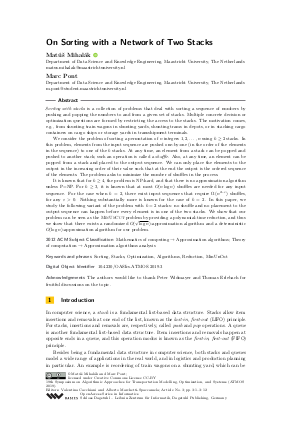@InProceedings{mihalak_et_al:OASIcs.ATMOS.2019.3,
author = {Mihal\'{a}k, Mat\'{u}\v{s} and Pont, Marc},
title = {{On Sorting with a Network of Two Stacks}},
booktitle = {19th Symposium on Algorithmic Approaches for Transportation Modelling, Optimization, and Systems (ATMOS 2019)},
pages = {3:1--3:12},
series = {Open Access Series in Informatics (OASIcs)},
ISBN = {978-3-95977-128-3},
ISSN = {2190-6807},
year = {2019},
volume = {75},
editor = {Cacchiani, Valentina and Marchetti-Spaccamela, Alberto},
publisher = {Schloss Dagstuhl -- Leibniz-Zentrum f{\"u}r Informatik},
address = {Dagstuhl, Germany},
URL = {https://drops.dagstuhl.de/entities/document/10.4230/OASIcs.ATMOS.2019.3},
URN = {urn:nbn:de:0030-drops-114159},
doi = {10.4230/OASIcs.ATMOS.2019.3},
annote = {Keywords: Sorting, Stacks, Optimization, Algorithms, Reduction, MinUnCut}
}

 Creative Commons Attribution 3.0 Unported license
Creative Commons Attribution 3.0 Unported license

















